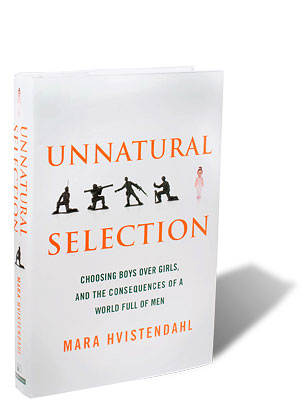
Largely as a result of sex-selective abortions, Asia today is short of 160 million women. They have disappeared silently over several decades, but their absence can be seen in classrooms filled with boys, in huddles of bachelors on city streets and in higher rates of bride trafficking and prostitution elicited by growing numbers of sexually frustrated men.
Researchers often speak of Asia’s missing women as a consequence of a traditional favoring of sons. Beijing-based science journalist Mara Hvistendahl acknowledges this in her groundbreaking new book, Unnatural Selection: Choosing Boys over Girls, and the Consequences of a World Full of Men, but argues that the imbalance is “an outgrowth of economic progress, not backward traditions.”
Countries like India and China, viewing smaller populations as a path to economic development, encourage lower birthrates — and couples having fewer children will, in many cases, do anything to ensure that those children are boys. “Anything” means sex-selective abortion on a massive scale, aided by medical technology that can detect fetal sex at 20 weeks’ gestation. Wealthy urbanites with easy access to health care — and a consumer’s sense of entitlement — lead the demand. They want sons, and they’ll get them, skewing the sex ratio from a natural 105 boys for every 100 girls at birth to 112 in India and 121 in China.
How did abortion become such a pervasive practice in Asia? Hvistendahl’s harshest critiques fall on Cold War — era Western population-control activists working for organizations like the U.N. Population Fund. They viewed abortion, she contends, as a means of birth control in the developing world. Fearful that countries with large populations would suffer economic instability and fall prey to communism, U.S. officials in particular pressured Asian governments into liberalizing abortion laws. States adopted population-control targets in return for aid, and birthrates fell, but women who had undergone abortion in the name of population control soon found another use for the procedure. Combined with quick ultrasound checks for fetal sex, abortion could do away with unwanted girls. “What then?” Hvistendahl asks. If couples choose boys, “what will be the effect on our society?” Her answers are unsettling.
Many men, unable to find wives, seek sex and companionship in brothels; others pay traffickers for abducted brides. In recent years, thousands of women from Vietnam have been smuggled into China to work as prostitutes or be sold into marriage. Vietnam also provides a source of mail-order brides for bachelors in Taiwan and South Korea. And in India, Hvistendahl notes, high murder rates aren’t found in the poorest regions but in those with the biggest sex-ratio imbalance.
Hvistendahl ominously notes that women will soon begin disappearing from other regions as the global middle class expands. Already, demographers see imbalances in Albania and the Caucasus. New technology has even made sex selection possible before pregnancy, enabling couples undergoing in vitro fertilization to select sex while checking for genetic conditions. “In China and California alike, mothers have become their own eugenicists,” says Hvistendahl.
Ultimately, the totality of these private decisions has created the problem. Like “the owner of a single-occupancy SUV who convinces himself his environmental impact isn’t really that bad,” Hvistendahl writes, couples choosing boys often assume that others will have girls and that somehow a balance will be achieved. But today, as her alarming book reveals, nature can too easily be made unnatural.
See “After Murder, South Korea Rethinks Marriage Brokers.”
See TIME’s Pictures of the Week.